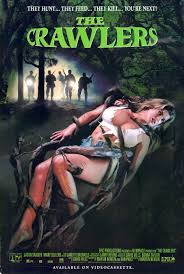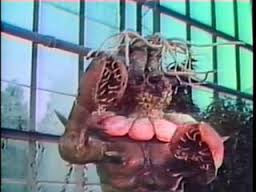It’s autumn, and the farmer’s market tables are groaning with gorgeous produce, tempting even the most tentative cooks to get out the salad spinner and channel their inner Julia Child. But what if the produce fought back? In honor of the season, here are a few cinematic monsterpieces where the plants rule.
I’m Your Venus (Flytrap)
We’ve all heard of the nearly unwatchable 1978 Attack of the Killer Tomatoes (and its George-Clooney-career-launching sequel, Return of the Killer Tomatoes, 1988), but other than rampaging members of the nightshade family, perhaps the most commonly seen plant monster in film is some variation of the Venus flytrap. In real life, the plant entices insects between two leafy lobes that snap shut, trapping the prey, which is slowly digested. The potential for gruesome movie mayhem is obvious.
A classic example of the Venus flytrap(esque) movie monster appears in the beloved-but-cheesy 1960 Roger Corman Little Shop of Horrors, a horror-comedy in which Seymour, who works in a rundown flower shop, attempts to hide the fact that his strange and unusual plant—the one that’s drawing in the business that’s keeping the shop afloat—survives on human flesh and blood. Little Shop was remade in 1986 as a musical, with Rick Moranis as Seymour and Levi Stubbs as the voice of the killer plant. The music in the remake is fantastic, and it features classic cameos by Bill Murray and Steve Martin. Both versions are well worth a watch.
There are probably dozens of other cinematic Venus flytraps, but a few worth noting are the one in the interstitial cartoon in Creepshow 2 (1987), where a pack of bullies gets a very severe comeuppance; the monster in the utterly bizarre Please Don’t Eat My Mother (1973), which is essentially a softcore porn version of Little Shop of Horrors (not for the kiddies); the inquisitive-looking pod we get a glimpse of in the Room of Requirement in Harry Potter and the Deathly Hallows Part II (2011); the Brendan Fraser vs. flytrap fistfight played (partly) for laughs in Journey to the Center of the Earth (2008); and the hungry plant in Dr. Decker’s lab in Konga (1961), which is last seen chomping on a character whose fate was probably left on the cutting-room floor.
These Roots Were Made for Walking
In Shakespeare’s Macbeth, the embattled king gets cocky when witches tell him he won’t be conquered until “great Birnam wood to high Dunsinane Hill shall come.” Macbeth, like many hapless protagonists since, shouldn’t have sold the foliage short. From the pissed-off apple trees in the Wizard of Oz (1939), to their stoned hippy cousins on Living Island in Pufnstuf (1970), to the boy-swallowing tree in Poltergeist (1982), to Treebeard in the Lord of the Rings movies, anthropomorphic trees have been a regular, if not frequent, mainstay of fantasy and horror film. And most of them aren’t as benevolent as Groot (Guardians of the Galaxy, 2014.)
One of the most fun entries in the Trees with Attitude genre is the 2000 film Trees. The plot that might sound familiar: In a small town menaced by a predator, the mayor refuses to close down holiday weekend festivities for fear of losing tourist dollars, causing tragedy and forcing a lawman, a grizzled eccentric, and a scientist to go on the hunt for the ferocious beast—a great white . . . pine. Yes, Trees is a lovingly-created Jaws parody, complete with chumming, a version of that great opening skinny-dipping scene, and the tagline, “Its bite is worse than its bark.” There is no movie that will make you laugh as hard at fertilizer.
On the opposite end of the spectrum—unintentionally hilarious—is From Hell It Came (1957). A South Pacific islander, Kimo, is condemned to death by his tribe and ritually killed and buried in a wooden coffin. But the island has a high level of radiation, and a combination of the radiation and the ritual he was buried with fuse Kimo and his coffin and resurrect him as a tree demon called a Tabanga. There are sub-plots about non-islander scientists scheming and islanders scheming and radiation that doesn’t scheme but probably would if it could, and a girl-on girl fight for good measure. (Sadly, it doesn’t involve Joan Collins.) But the best part is the tree monster, which looks like one of those yellow-eyed chocolate Easter bunnies after it’s been run over by a truck. Spoiler alert: There’s something in this movie to offend just about everybody.
After that, it’s just a short leap to radioactive killer tree roots, right? The Crawlers (1993) involves a town menaced by evil tree roots created by—no surprise—illegal dumping of toxic waste. The film is also called Troll III, and like the cult sensation Troll II (1990), it (a) is virtually unwatchable, and (b) has no discernable trolls (although Troll II does have goblins). Check this one out only if you’re a soup-to-nuts-killer-plant-movie completionist.
Sinners in the Grasp of an Angry Pod
In 1949, Roald Dahl, author of Charlie and the Chocolate Factory, wrote a short story for adults called “The Sound Machine,” about a machine that allowed its creator to hear plants scream when they were cut, which nearly drove the inventor mad. This theme of plants having sensation—and fighting back—pops up in several films. In Dr. Terror’s House of Horrors (1965), one of Amicus Productions’ horror anthologies, a family is menaced by a killer vine that grows all over their house, kills the dog, cuts the phone lines, and traps them inside. In Day of the Triffids (1962), a meteor renders most people on earth blind and at the mercy of the triffids, plant-creatures that sting their victims and feed on the carcasses. And, never one to leave well enough alone, M. Night Shyamalan takes the idea to a new extreme in The Happening (2008), in which plants rise up against humans by releasing a toxin that makes huge numbers of people kill themselves.
Sisterhood of the Traveling Plants
Another common theme is hapless travelers or explorers encountering malicious plants abroad. A great example of this subgenre is The Lost Continent (1968), in which a bunch of people headed for South America by ship are stranded on an island of carnivorous seaweed, along with giant crab monsters and Spanish conquistadors who have somehow managed to survive for hundreds of years. In the rather terrible Maneater of Hydra (1967), a “vampire tree” cultivated by a mad doctor picks off unsuspecting tourists, who apparently can’t run away from a stationary plant. Possibly worse is The Woman Eater (1958), in which a scientist, Dr. Moran, travels to the jungles of South America and brings back a plant that produces a chemical that can bring people back to life—if the plant is fed a steady stream of nubile young women. The plant is ridiculous, and its primary tentacles look like spray-painted boxing gloves.
One of the better and more recent entries in this category is The Ruins (2008), from the novel by Scott Smith. A group of young tourists visit a ruined temple in a clearing off the beaten path in Mexico, ignoring several warning signs (as ignorant tourists always do in movies). When they enter the clearing, they’re forced up on to the top of the temple by men with bows and arrows. Soon they realize they’ve been placed in quarantine with a carnivorous vine that isn’t quite sentient, but is definitely capable of messing with their heads while it slowly eats them, one at a time.
I’m Not Half the Man I Used to Be
Plenty of films feature people who transform—or are transformed—into plants, which in turn are rarely benevolent beings. One of the very worst and most messed-up of these is The Revenge of Dr. X (made 1966, released 1970). Dr. Bragan, a mad doctor who looks a bit like Lon Chaney Jr. during his tippling years, goes to Japan after a nervous breakdown and, with the utterly inexplicable help of a Dr. Hanamura, a capable doctor with a penchant for negligees, crosses human and plant to create a monster with a taste for puppies and villagers and, like the one in The Woman Eater, boxing gloves for hands. You may wonder how a film can be so astonishingly bad until—perhaps tipped off by its gratuitous use of stock photography—you realize it was written by Ed Wood. Points for use of a volcano; points docked for not using it well.
Along the same lines is The Mutations (1974), starring horror icon Donald Pleasance as Professor Nolter, and Tom Baker as Lynch, his mutated sideshow henchman, who kidnaps comely women and the occasional guy for Nolter’s experiments. Lynch wants Nolter to make him look normal, but Nolter is more interested in creating a plant-man. Naturally, everything goes awry, and the man-plant runs amok. There’s a scene where Nolter feeds one of his plants a live rabbit by opening what could only be a mailbox slot in the plant’s trunk/stalk, and another with the denizens of the sideshow that’s clearly a nod to Tod Browning’s Freaks. It’s not great cinema, but there’s some fine scenery-chewing by Pleasance and Baker.
Apparently Tom Baker couldn’t outrun the murderous man-plants, because he faced off against one again as Dr. Who in the Seeds of Doom series (1976). The Doctor and his companion Sarah Jane are in the Arctic at a research station when two shady characters, Scorby and Keeler, steal two frozen alien plant pods for their wealthy, plant-loving boss, Chase. Keeler is exposed to the contents of a pod and becomes a humongous, jiggly, tentacled plant creature that looms over Chase’s mansion, while Chase tries to make compost out of the Doctor and Sarah.
(And speaking of alien contact turning people into plants, Creepshow (1982) features a story where a farmer played by Stephen King—which will never win him an Oscar—turns into a plant monster after burning his fingers on a meteorite that lands in his back yard.)
Less amusing and more depressing is Matango (1963), a Japanese film about day-cruise yacht passengers shipwrecked on an island. It’s devoid of MaryAnn’s coconut cream pie, but it is covered with mushrooms that the survivors fear might be poisonous. They take shelter in a derelict ship, and as their supplies dwindle, one by one they succumb to eating the mushrooms, which turns them into mushroom people.
Once in a while, cinematic human-plant hybrids are lucky enough to be able to shift between human and plant form. In The Guardian (1990), a professional couple, Phil and Kate, hires a nanny, Camilla, to care for their baby, Jake. Over time, they begin to suspect Camilla may have ominous plans for Jake, and soon learn Camilla is some sort of Druid/tree spirit/dryad who can shift from human to tree and has a habit of sacrificing babies to keep her sacred oak fed. She also has a pack of hungry wolves to do her bidding. Maybe they’re secret werewolves who understand what it’s like to live dual lives.
So, kiddies, that ends my roundup (no pun intended) of killer plant movies. Remember, don’t go eating strange mushrooms or sticking your head in Venus flytraps, and definitely don’t feed the plants.




Leave a Reply